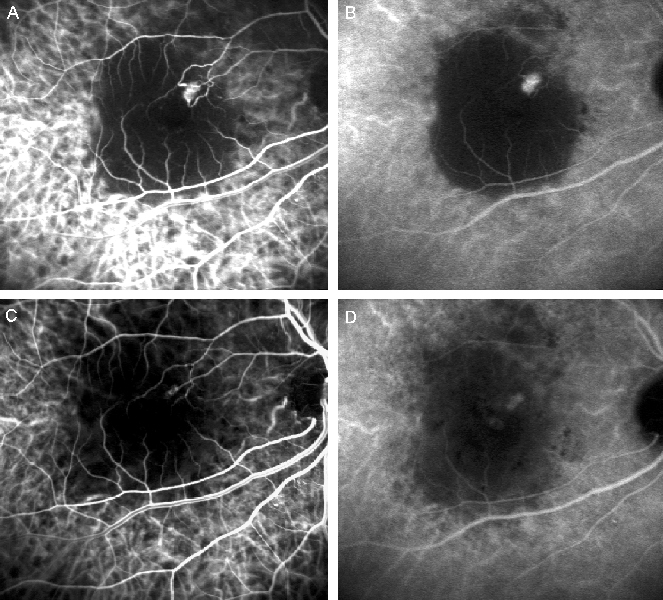Korean J Ophthalmol.
2007 Dec;21(4):213-215. 10.3341/kjo.2007.21.4.213.
Retinal Angiomatous Proliferation and Intravitreal Bevacizumab Injection
- Affiliations
-
- 1Department of Ophthalmology, Samsung Medical Center, College of Medicine, Sungkyunkwan University, Seoul, Korea. swkang@smc.samsung.co.kr
- KMID: 754638
- DOI: http://doi.org/10.3341/kjo.2007.21.4.213
Abstract
- PURPOSE: To evaluate the short-term efficacy and safety of intravitreal bevacizumab injection (IVBI) in patients with retinal angiomatous proliferation (RAP). METHODS: Seven eyes of 5 patients with RAP were included in this study. All of the eyes evidenced stage 2 RAP lesions, except for one eye with a stage 3 lesion. IVBI (1.25 mg/0.05 cc) were conducted at 4 or 6-week intervals. Complete ocular examinations, angiographic results and optical coherence tomographic findings before and after the IVBI were analyzed at baseline and upon the follow-up visits. RESULTS: Seven eyes were studied in 5 patients who had undergone IVBI. Partial (3 eyes) or complete (4 eyes) regression of RAP was noted after IVBI in all of the studied eyes. Visual acuity improved in 5 of the eyes, and was stable in 2 of the eyes. One eye evidenced severe intraocular inflammation after IVBI and a subsequent development of new RAP, which was controlled with vitrectomy and repeat IVBI. CONCLUSIONS: This treatment was effective over 6 months, stabilizing or improving visual acuity and reducing angiographic leakage. These short-term results suggest that IVBI may constitute a promising therapeutic option, particularly in the early stages of RAP.
MeSH Terms
-
Aged
Aged, 80 and over
Angiogenesis Inhibitors/*administration & dosage
Antibodies, Monoclonal/*administration & dosage
Female
Fluorescein Angiography
Follow-Up Studies
Fundus Oculi
Humans
Injections
Male
Middle Aged
Retinal Neovascularization/complications/*drug therapy/pathology
Treatment Outcome
Vascular Endothelial Growth Factor A
Visual Acuity
Vitreoretinopathy, Proliferative/complications/*drug therapy/pathology
Vitreous Body
Figure
Cited by 1 articles
-
Twelve-Month Outcomes of Intravitreal Anti-Vascular Endothelial Growth Factor Therapy for Retinal Angiomatous Proliferation
Deok Bae Kim, Jae Hui Kim, Seong Hun Jeong, Tae Gon Lee, Jong Woo Kim, Chul Gu Kim, Sung Won Cho, Dong Won Lee, Jung I1 Han
J Korean Ophthalmol Soc. 2013;54(11):1700-1707. doi: 10.3341/jkos.2013.54.11.1700.
Reference
-
1. Yannuzzi LA, Negrao S, Iida T, et al. Retinal angiomatous proliferation in age-related macular degeneration. Retina. 2001. 21:416–434.2. Gass JD, Agarwal A, Lavina AM, Tawansy KA. Focal inner retinal hemorrhages in patients with drusen: an early sign of occult choroidal neovascularization and chorioretinal anastomosis. Retina. 2003. 23:741–751.3. Hartnett ME, Weiter JJ, Staurenghi G, Elsner AE. Deep retinal vascular anomalous complexes in advanced age-related macular degeneration. Ophthalmology. 1996. 103:2042–2053.4. Kuhn D, Meunier I, Soubrane G, Coscas G. Imaging of chorioretinal anastomoses in vascularized retinal pigment epithelium detachments. Arch Ophthalmol. 1995. 113:1392–1398.5. Blodi CF, Russell SR, Pulido JS, Folk JC. Direct and feeder vessel photocoagulation of retinal angiomas with dye yellow laser. Ophthalmology. 1990. 97:791–795.6. Borrillo JL, Sivalingam A, Martidis A, Federman JL. Surgical ablation of retinal angiomatous proliferation. Arch Ophthalmol. 2003. 121:558–561.7. Boscia F, Furino C, Prascina F, et al. Combined surgical ablation and intravitreal triamcinolone acetonide for retinal angiomatous proliferation. Eur J Ophthalmol. 2005. 15:513–516.8. Boscia F, Parodi MB, Furino C, et al. Photodynamic therapy with verteporfin for retinal angiomatous proliferation. Graefes Arch Clin Exp Ophthalmol. 2006. 244:1224–1232.9. Bottoni F, Massacesi A, Cigada M, et al. Treatment of retinal angiomatous proliferation in age-related macular degeneration: a series of 104 cases of retinal angiomatous proliferation. Arch Ophthalmol. 2005. 123:1644–1650.10. Kuroiwa S, Arai J, Gaun S, et al. Rapidly progressive scar formation after transpupillary thermotherapy in retinal angiomatous proliferation. Retina. 2003. 23:417–420.11. Okamoto N, Tobe T, Hackett SF, et al. Transgenic mice with increased expression of vascular endothelial growth factor in the retina: a new model of intraretinal and subretinal neovascularization. Am J Pathol. 1997. 151:281–291.12. Lopez PF, Sippy BD, Lambert HM, et al. Transdifferentiated retinal pigment epithelial cells are immunoreactive for vascular endothelial growth factor in surgically excised age-related macular degeneration-related choroidal neovascular membranes. Invest Ophthalmol Vis Sci. 1996. 37:855–868.13. Wells JA, Murthy R, Chibber R, et al. Levels of vascular endothelial growth factor are elevated in the vitreous of patients with subretinal neovascularisation. Br J Ophthalmol. 1996. 80:363–366.
- Full Text Links
- Actions
-
Cited
- CITED
-
- Close
- Share
- Similar articles
-
- A Case of Retinal Hemorrhage Following a Dexamethasone Intravitreal Implant
- Comparison of Bevacizumab and Combined Low-dose Bevacizumab and Triamcinolone in Central Retinal Vein Occlusion
- Combined Low Dose Bevacizumab-triamcinolone versus Bevacizumab Single Intravitreal Injection for Branch Retinal Vein Occlusion
- Macular Vessel Density Analysis Using Optical Coherence Tomography Angiography before and after Intravitreal Bevacizumab Injection in Branch Retinal Vein Occlusion
- The Short-term Effect of Intravitreal Bevacizumab for Treatment of Central Serous Chorioretinopathy


